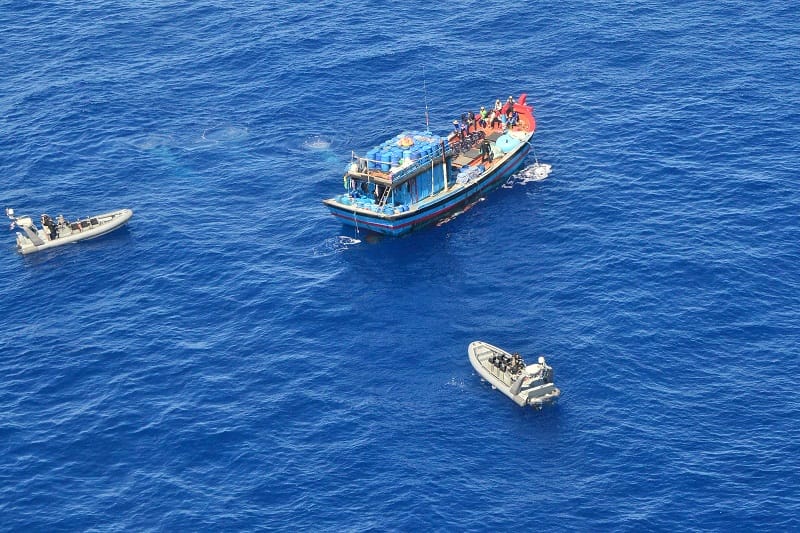The Indian Ocean, a critical hub for global trade and strategic interests, is seeing a stronger Australian presence due to dynamic partnerships with India, the United States, Japan, and Sri Lanka. In 2024 and 2025, Australia increased maritime cooperation through joint naval exercises, capacity-building initiatives, and regional engagements, stimulating Indo-Pacific collaboration and stability. These efforts, ranging from high-intensity drills like Exercise Malabar to transformative support for Sri Lanka’s maritime capabilities, show a shared commitment to a free and open maritime order. A recent interview with Lalita Kapur, Australia’s Deputy High Commissioner to Sri Lanka, shows the range of this cooperation, bringing out not only security partnerships but also economic and people-to-people ties that are driving positive outcomes in the region.
Exercise Noble Dingo: Quad in the Bay of Bengal
In February 2024, Australia joined the United States and Japan for Exercise Noble Dingo, a two-day trilateral naval exercise in the Bay of Bengal. The Royal Australian Navy’s Anzac-class frigate HMAS Warramunga operated alongside USS Halsey of the U.S. Navy and JS Sazanami of the Japan Maritime Self-Defense Force, en route to India for Exercise Milan. The drill included tactical maneuvers, coordinated helicopter operations, and anti-submarine and anti-surface warfare exercises, culminating in combined gun firing. As part of Australia’s Indo-Pacific regional presence deployment, Noble Dingo showcased the growing interoperability among Quad partners (Australia, India, US, Japan), laying the groundwork for broader multilateral cooperation. This exercise highlighted Australia’s ability to integrate seamlessly with allies, reinforcing a collective stance on regional security.
Exercise Malabar 2024: A Quad Cornerstone in Vishakhapatnam
The quadrilateral Exercise Malabar 2024, hosted by the Indian Navy in Vishakhapatnam in October 2024, marked a high point in Australia’s collaboration with India, the US, and Japan. This complex exercise involved advanced naval assets, including destroyers, frigates, submarines, and aircraft, engaging in anti-surface, anti-air, and anti-submarine warfare drills, joint maneuvers, and live weapon firings. Malabar, a key pillar of the Quad’s maritime security strategy, demonstrated operational cohesion and a unified response to regional challenges, particularly China’s growing naval assertiveness. Australia’s participation, following its hosting of Malabar in 2023, underscored its pivotal role in fostering trust and tactical coordination among Quad allies, ensuring the Indian Ocean remains a secure and open domain.
Strengthening Ties with Sri Lanka
Australia’s Indo-Pacific Endeavour (IPE) 2024 and 2025 initiatives have been instrumental in deepening ties with Sri Lanka and other Indian Ocean nations. IPE 2024 included activities in Sri Lanka focused on regional engagement, maritime enforcement, humanitarian assistance, disaster relief, and capacity building. These efforts have strengthened Sri Lanka’s ability to address maritime threats and respond to natural disasters, fostering resilience in a strategically vital region. IPE 2025, currently underway, continues this engagement, with Australian Defence Force personnel collaborating with partners across Southeast Asia and the Northeast Indian Ocean to enhance maritime security cooperation. This people-centered approach has built goodwill and practical partnerships, reinforcing Australia’s role as a reliable regional ally.
HMAS Sydney’s Deployment
As of July 2025, the Royal Australian Navy destroyer HMAS Sydney is actively deployed in the Indian Ocean as part of its 2025 Regional Presence Deployment. Departing Singapore in late June, HMAS Sydney joined a UK-led carrier strike group centered on HMS Prince of Wales, conducting exercises with navies from the UK, Norway, Spain, New Zealand, and others. This multinational training, ahead of Exercise Talisman Sabre in July, underscores Australia’s commitment to a robust naval presence in the Indo-Pacific. By operating alongside allies in the Indian Ocean, HMAS Sydney reinforces the importance of collective security in safeguarding vital maritime routes.
Australia’s Support to Sri Lanka
A landmark moment in Australia-Sri Lanka collaboration came in February 2025, when Australia donated a state-of-the-art Kongsberg EM2042 Shallow Water Multi-Beam Echo Sounder (MBES) to the Sri Lanka Navy Hydrographic Service. Handed over at Colombo Port in a ceremony attended by senior naval and Australian officials, this advanced equipment enhances Sri Lanka’s sovereign capability to map its ocean floor and produce up-to-date nautical charts, critical for maritime trade, navigation safety, and security. This donation builds on Australia’s extensive support, including a multi-million-dollar fuel grant since 2022, a King Air 350 maritime surveillance aircraft for the Sri Lanka Air Force, and two A-class vessels with all-terrain vehicles, all of which bolster Sri Lanka’s capacity to counter maritime threats like people smuggling and illegal fishing.
At the Sri Lanka Coffee Festival 2025 in Kandy City Centre, Westvu had the opportunity to interview Australia’s Deputy High Commissioner Lalita Kapur about the Australia-Sri Lanka collaboration. When asked about their partnership, she pointed out its breadth and depth: “We try to cooperate across the whole range of areas, so you have a lot of people who are looking at the financials, and we have great relationships with the financials, also in border security, as you mentioned, but in other areas too, so we’re always looking at the linkages that we can create.”
She also said. “ We’re always looking for opportunities to help partners in Sri Lanka. I think we have quite a broad range of areas, but the relationship just keeps growing.” Most notably, she mentioned the strength of people-to-people links: “The people-to-people links are probably the best part of it.”
Australia’s collaboration with India, the US, Japan, and Sri Lanka is driven by a shared commitment to a secure and open Indo-Pacific. Exercises like Malabar, Noble Dingo, and AUSINDEX (Australia-India) enhance interoperability and counter regional challenges, such as China’s expanding naval presence and threats to critical sea lanes carrying majority of global maritime oil trade. Australia’s support to Sri Lanka, including advanced equipment and humanitarian aid, strengthens regional resilience against maritime threats and economic instability. This multifaceted strategy mix high-end warfighting drills with capacity-building and development, shows Australia’s leadership as a regional partner. Meanwhile, Sri Lanka, despite being a small island nation, will play an important role in the future, particularly through the QUAD strategy.





